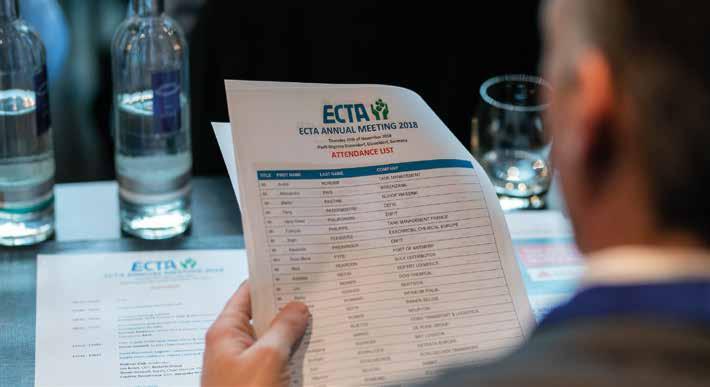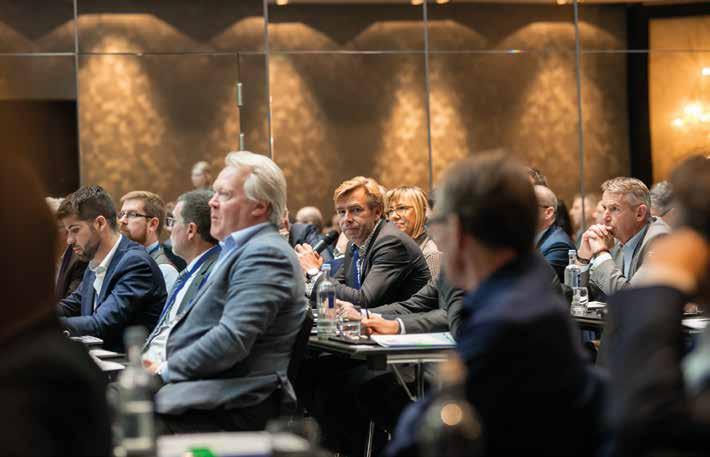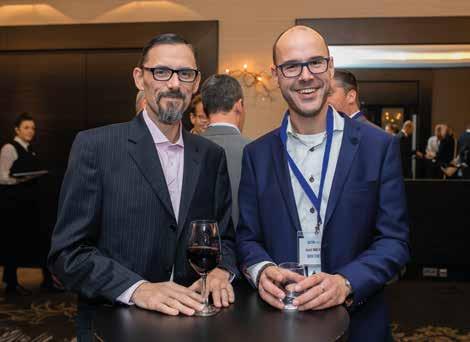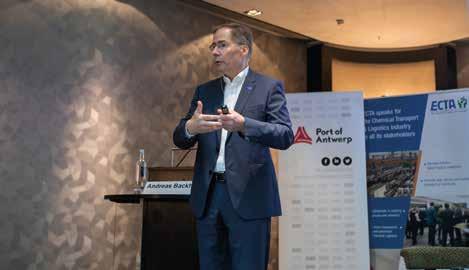
17 minute read
Talking chemical transport with ECTA
A GRAND DAY OUT
REPORT • ECTA’S ANNUAL MEETING IS ALWAYS AN EVENT TO LOOK FORWARD TO AND THE 2018 MEETING HAD PLENTY TO OFFER FOR BOTH CHEMICAL PRODUCERS AND LOGISTICS PROVIDERS
THE EUROPEAN CHEMICAL Transport Association’s (ECTA) 2018 Annual Meeting took place as usual at the Hyatt Regency Düsseldorf this past 29 November, with a packed agenda for the one-day event. The meeting room was packed too, perhaps not surprisingly after what ECTA president Andreas Zink, director of LKW Walter, termed “quite a challenging year”.
Companies involved in the transport of chemicals in Europe had faced continuing challenges from driver shortages and, after hot weather through the summer, low water levels on the Rhine. In addition, they were experiencing issues relating to the interpretation by chemical shippers of the Safety & Quality Assessment for Sustainability (SQAS) audit scheme. On the upside, ECTA and its partner organisations had brought the electronic EFTCO Cleaning Document – eECD – to fruition.
Speakers throughout the sessions spoke at length about these and other issues facing the European chemical sector and its logistics service providers (LSPs), at the end of which they and the audience were rewarded with a fine dinner and yet more to chew over in the shape of a hard-hitting presentation on cyber-security.
OPEN THE GATES Of all the major European chemical manufacturers, BASF has been at the forefront of several logistics advances in recent years, perhaps helped by the concentration of its activities at the massive Ludwigshafen plant in Germany and a few other large facilities. Indeed, BASF had alerted the ECTA audience to its initiatives at other annual meetings in recent years, and Andreas Backhaus, senior vice-president, European site logistics operations at BASF, brought the 2018 meeting up to date.
Backhaus’ presentation was couched in terms of the ways in which day-to-day operations at BASF will – indeed, must – change, giving a model to other chemical manufacturers. He said that there are some things that industry has to come together to fix but that a company such as BASF has plenty that it can do on its own.
High on BASF’s agenda was investigation of how it can reduce gate-to-gate times for vehicles loading and/or unloading at its plants. At Ludwigshafen, for instance, such times can be anything from two to five hours, which is not acceptable. It is, though, quite a challenge at such a large site, where it may take a vehicle up to an hour just to drive from the gate to the loading/unloading point and back again. And there is the sheer scale of operations: Ludwigshafen handles around 2,100 trucks every day, as well as 400 rail cars
PROBLEMS IN THE SUPPLY CHAIN IN
and, in a normal year, 20 barges. It also has 106 km of roads within the site boundary – and drivers can get lost.
But inefficiency in the loading/unloading process blocks the production cycle. BASF saw the process of addressing gate-togate times as part of its overall digitisation process. Optimising gate-to-gate times requires good planning and this means involving transport companies and freight forwarders. “Truck drivers just turning up doesn’t work any more,” Backhaus said. It leads to congestion and inefficiency.
To address the issue, BASF developed its OPTIMiSM software, which allows it to plan all operations at all loading points for all modes. Customers or hauliers use the system to book time slots. This system is currently being rolled out and will be followed by a yard execution system that will collect all relevant data for loading/unloading. BASF will reach out to customers and hauliers for their input, so as to create a link to the gate and the loading point. It will also include a tool to all drivers to check themselves in at the gate.
LOAD THE PILOT In addition, BASF is piloting a pre-check system, through which vehicles are checked before they enter the site rather than at the loading point. This will lead to faster acceptance, fewer rejections and less wasted time. The use of the eECD, to which BASF has signed up, will contribute similar benefits.
On the hardware side, BASF is improving infrastructure at the main gate, extending the building and providing more parking space both inside and outside the gate. In the future, it may also be possible to move logistics operations to an external area, applying a ‘drop and swap’ system, which could cut turnaround times to a few minutes. In the nearer term, new automated loading stations are being installed – four were already complete, with another 22 due for installation in 2019 – that offer ‘smart filling’ by being linked directly to inventory management systems.
BASF has also set up a new team to draw up detailed schedules for loading points. This has also helped improve turnaround times. There is the potential for that process to be automated, Backhaus said.
BASF has also been extending the use of automated guided vehicles (AGVs) to move product around the Ludwigshafen site in 40foot ‘BASF-class’ tank containers. After a successful trial, three new AGVs have been added and are delivering in-plant efficiencies, Backhaus said – although it has been a bit of a challenge to get people used to the idea of self-driving trucks moving around the site.
Summing up, Backhaus said that the work that BASF is doing is an example of a change of mindset; it is no longer inwardly focused and holding on to its own data. The sort of predictive analytics that are needed to generate the efficiencies that it is looking for rely on the sharing of data. That concept offers a lot of benefits for the logistics sector as a whole.
THE VIEW FROM CEFIC There were plenty of familiar faces in the audience at the ECTA meeting but a few missing, among them Jos Verlinden, logistics director at the European Chemical Industry Council (Cefic), who was due to retire at the end of the year. In his place, Simon Goswell, supply chain director, EMEA at LyondellBasell and chair of the Cefic Supply Chain Issue Team, introduced delegates to “the new Cefic”. He described the new structure Cefic adopted in 2018 and its greater focus on advocacy, asking: “What does that mean for the supply chain group?”
In 2011, Cefic published its Chemical Logistics Vision 2020 document, which had three main elements: safety, sustainability and improving processes through collaboration. That vision is still the same, Goswell said, and Cefic has delivered on those objectives. It has not done that on its own, though – there has been a lot of collaborative work, not least in partnership with ECTA.
The backdrop to current discussions in terms of the chemical supply chain covers both legislative and operational issues. On the one hand there is the drive towards a modal shift away from road transport, the European Commission’s (EC) recent Mobility Package, and increasingly tough requirements for emissions reduction. In purely operational terms, there are issues such as road congestion, driver shortages, rail reliability and a lack of connectivity, water level problems, and port congestion.
Legislation and policy in the freight transport sector has the unfortunate habit of focusing on individual modes, Goswell said. That means that while there is a lot of investment and frequent initiatives, there is no cohesive approach. As such, the Cefic Supply Chain Issue Team has set some priorities, including a position paper on the EC Mobility Package, where it has some concerns, especially in respect of drivers. A position paper on rail and intermodal transport had »

recently been approved by the Cefic Board. And it is looking at the carbon dioxide emissions calculation methodology, which has been criticised.
Also during 2018, Cefic provided support and encouragement in the development of the eECD, undertook the 2019 revision of SQAS, and is participating in the development of a Risk Management Framework for dangerous goods alongside EC and the EU Agency for Railways (ERA). Goswell ended by reporting that Cefic was due to move to new offices in January 2019; it is now located at 40 Belliard, B-1040 Brussels.
WHAT DOES THE TEAM THINK? After his presentation, Goswell joined a panel session, moderated by Andreas Zink, alongside Jan Arnet, CEO of the Bertschi Group, and Frédéric Derumeaux, CEO of the Vervaeke Group. Goswell began by noting that there are big problems in terms of the need for more infrastructure investment, but it is hard to control that. “What we can control,” he said, “is the development of the end-to-end supply chain conversation”. Without that, “we will always be sub-optimal”.
Derumeaux said that LSPs are facing increasing demands from their customers for more digitisation. Referring back to Backhaus’s presentation, he also noted that plants and terminals are beginning to compete on their ability to turn vehicles around quickly. Arnet’s view of the current issues facing LSPs is that there is a need for more integration. And, while there is undoubtedly a shortage of drivers, there is also a shortage of qualified people in many positions. “The challenge is to attract people to the industry across the board,” he said. “It’s not that attractive.”
Derumeaux’s opinion was that drivers are leaving the sector because of long waiting times. “Things are easier in container haulage,” he said. “We have to do something – if we don’t have drivers we have a big problem.” Arnet suggested going to areas of low employment and setting up schools for drivers, and also noted that one traditional source of truck drivers – the army – is not producing enough people any longer. “Truck driving is not seen as a good occupation,” Derumeaux added.
Goswell was of the opinion that asset utilisation – and that includes human assets – is ineffective in the sector. Detaching the load from the actual shipment is the way to go, he said. The use of ‘drop and swap’ operations is attractive but, Derumeaux said, there is a risk of disconnecting the driver from the vehicle.
Goswell summed up the panel session with the observation that “We have to understand where we are before we can change it.” And, while the audience digested that snippet of wisdom, lunch was served.

THE ELECTRIC PORT The extent of possibility offered by digitisation was ably illustrated by Erwin Verstraelen, chief digital innovation officer at the Port of Antwerp. Verstraelen took the position when it was created in 2017, with a remit to look at ways in which Industry 4.0 concepts could address the challenges being posed by increasing throughput in the port: notably growing pressure on space within the port and increasing congestion on roads and inland waterways. The solutions that the port is implementing require collaboration outside its boundaries, including with other ports.
“Creating a digital ecosystem is part of the port’s response to those challenges and it runs through most projects and initiatives,” Verstraelen explained. “Our role is to enable innovation in the port.” He described four initiatives that have been put in place within the previous 12 months: • Portxl, which brings relevant start-ups into the port community and inspires new ideas • NxtPort, a data platform that brings all stakeholders together • Chainport, which brings together a group of 12 major ports around the world to exchange information and ideas • Beacon, an Internet of Things (IoT) accelerator and ideas hub.
There are, Verstraelen said, several drivers for digitisation in the chemical supply chain. Maturing technologies bring new tools and opportunities at lower prices; some of those opportunities offer the chance to take a lot of inefficiency out of the system; and the process of globalisation during the 1980s and 1990s was built on the technology of the time and is due for an overhaul.
NxtPort, launched in early 2017, is fundamental to a lot of the work going on in this area, and not just within the Port of Antwerp – it is also the platform on which the eECD operates. NxtPort provides a link not only for the port and its immediate customers and users but also for the hinterland community and overseas interests. It does not take a top-down approach, Verstraelen insisted: it was developed from a common realisation that something was needed.
“Stakeholders needed to trust each other and be willing to share data,” Verstraelen explained, and this took time. The first year of development was all about building the community and trust in the system. It was important that data owners can decide on who can see what information; NxtPort merely acts as a ‘data custodian’. Its core capability is to align and orchestrate data. This can speed up existing systems or prompt the redesign of systems for greater efficiency.
THE RIGHT PLATFORM As an example of where NxtPort can go, Verstraelen explained the concept of ‘next mode of transport’. Every container arriving in the Port of Antwerp will move on. There is someone in the transport chain who knows where the container will move to next and by what mode, but that data is often not available to the terminal, which introduces an inefficiency. Sharing that information before the container arrives can have a big impact on the efficiency not only of the terminal operator but also on the container itself, which can move on to its next destination more rapidly.
“Current pressures mean this is the ideal time to be working on this,” Verstraelen said. “We either sit and talk to each other or we all fail.”
The availability of big data sets and the use of analytics can also help with the modal shift of freight traffic, Verstraelen added. Antwerp aims to reduce its reliance on road transport from 51 per cent of freight traffic in 2014 to 40 per cent in 2030, with much of that moving to rail. The port authority has always said that it has no power to force LSPs to make that shift but, through digitisation, it can now provide the information that can make it happen. There is the potential to take a similar approach to moving freight onto inland waterways but there are some specific problems that must be addressed first.
As with the case of BASF, Verstraelen believes that digitisation can help ease the driver shortage and reduce inefficiencies. A working group is looking at promoting night-time openings and driving, while another platform supported by the port, HAKKA, aims to reduce empty vehicle moves by matching cargoes with available space. The port is also looking at the possibility of allowing the use of AGVs on roads within the port area.
“I believe we are heading for a perfect storm,” Verstraelen concluded. Labour issues, mobility and sustainability all need to be addressed and digitisation provides the tools to do so. “This is the ideal time to change mindsets,” he said. “We need to take the next step together.” »
THE OPENNESS DISPLAYED BY SPEAKERS AND
DELEGATES NEEDS TO BE REPLICATED IN THE


WORKING TOGETHER ECTA managing director Peter Devos brought the latest news of the eECD project, which had just gone live. “Subscribe now!” he said – BASF, Covestro and Evonik have all bought three-year licences, which Devos hoped would kick-start usage.
The story of the development of the eECD is a story of collaboration: ECTA worked alongside Cefic, the European Federation of Tank Cleaning Organisations (EFTCO) and the Belgian chemical industry association Essenscia; the same bodies have set up the European Chemical Logistics Information Council (Eclic), which was formed in March 2018, to administer the eECD system.
Application of eECD is now moving into a “learning by doing” phase, Devos said. Initially it will effectively be a manual system, until it can be integrated with other applications, such as Elemica. Other issues are emerging, notably how to run digital and paper versions in parallel.
Devos then led a panel session featuring Erwin Verstraelen, Michael Kubenz, CEO of Kube & Kubenz, and Simon Hardy, digital business network evangelist at Elemica. With the aim of discussing the standardisation of processes, Kubenz explained that his company is still investing a lot in its legacy systems. “We can’t operate without them any more,” he noted. Verstraelen assured the audience that there is no need to give up on legacy systems; rather, find a way of giving everyone access to data networks. This is likely to be easier for larger companies; small operators may not have the knowledge.
There has been disagreement over the need for standardisation of systems but Hardy said that standards give breadth. Once they are out there – and here he mentioned eECD again – then companies will adopt them. And systems such as Elemica and NxtPort can help by translating difference data sources. CARE IN THE COMMUNITY The final part of the day was left to Evert de Jong, Responsible Care director at ECTA, to give an update on developments with Responsible Care and SQAS. He began by summing up the 2017 results from the key performance indicator (KPI) reports from ECTA’s Responsible Care members. These showed continued increases in the number of movements and the total tonnage carried – now up to 101.6m tonnes – as well as more employees; on the other hand, there were also more incidents during transport and loading operations, which is worrying, even if there were fewer incidents at unloading points. Another concern is that 15 per cent of trucks used in the European chemical transport sector are Euro IV or earlier: there is a problem coming, de Jong said.
Cefic has been talking to its members after criticism has been expressed about the greenhouse gas (GHG) emission calculation methodology. ECTA and Cefic met in June 2018 to discuss the issue; it was decided to keep the subject in the KPI form but to make it voluntary. There was no agreement on revising the calculation guidelines. De Jong said that LSPs will probably be getting more questions from their customers on GHG emissions so they should keep making the calculation.
De Jong was also stern with some ECTA members who supply their KPI reports late; he wants the 2018 returns in February or March, not in October! Companies that consistently report late will have their


Responsible Care membership discontinued, he warned. On the other hand, he also reported that the Responsible Care workshop held by ECTA in October 2018 drew more than 50 participants, who provided a lot of input for ECTA’s 2019 programme. It was suggested that this level of interest indicates it may be worth holding two such events every year.
De Jong then turned to discussion of the revisions to the SQAS questionnaires for 2019. There are, he said, a lot of changes that will impact LSPs. Some of the questions that routinely get very high scores have been taken out: they provide no information. There have also been some textual changes for clarity.
But importantly – and this is something that LSPs will need to be alert to when they are being reassessed – several chapters have been moved around and issues of sub-contracting, GHG emissions and plastics waste now have separate chapters. The pre-assessment document has been subjected to considerable amendment, the attestation is deleted, and the summary report has been amended.
De Jong highlighted the issue of subcontractors. Some Cefic members have been unhappy about the level of control that LSPs have over their sub-contractors, which has led to the introduction of more questions on the topic for transport service providers. LSPs will also have to report the number of subcontractors used and the tonnages involved. ECTA is not happy with the extra work this will require and de Jong said he thought most LSPs will not have this data to hand.
THANK YOU AND GOODNIGHT It was a long day and delegates deserved the cocktails and dinner that were to follow, after a break to allow them to catch up on emails. Over dinner, Gerry Grant, who describes himself as ‘chief ethical hacking consultant’ working for the Scottish Business Resilience Centre, gave some tips to his audience on avoiding cyber-crime. “It takes a thief to catch a thief,” he began, but also noted that hackers are, by and large, lazy people. They go after easy targets, so there are some easy measures that can be taken to put them off.
Grant’s lively presentation ranged far and wide into areas that the audience may not even have thought about; it was also something of a scene-setter, as cybersecurity will become ever more significant as digitisation spreads through the supply chain. Look out for more on this topic during 2019. HCB
ECTA’S MEMBERSHIP REFLECTS THE REALITY OF THE
CHEMICAL TRANSPORT SECTOR, WHICH REMAINS LARGELY HCB will certainly look forward to ECTA’s activities this year; readers who want to know more should go to www.ecta.com; the website includes links to ECTA’s periodical newsletter, the October 2018 edition of which has more discussion of many of the topics on the agenda at the 2018 Annual Meeting.










